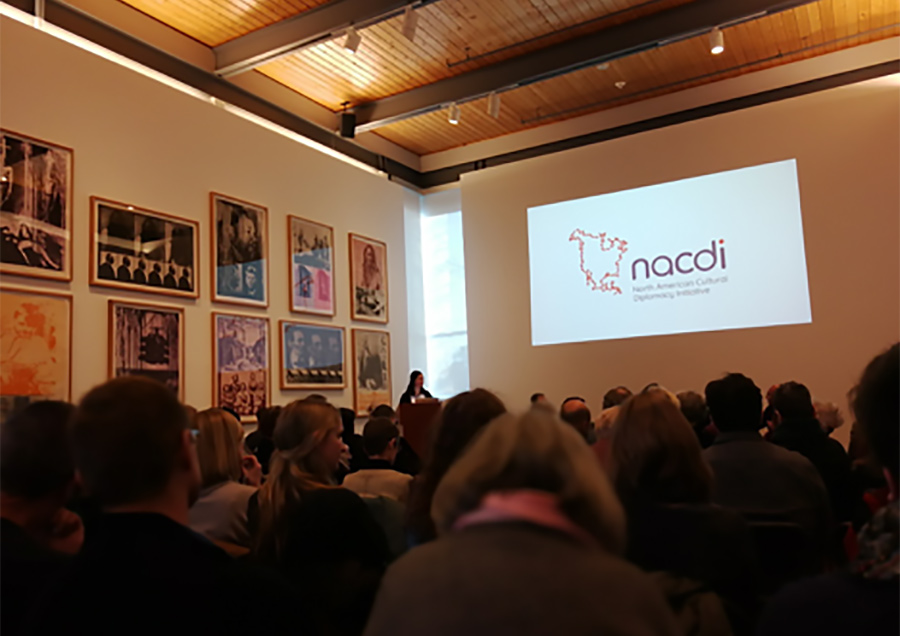13 January 2018
Agnes Etherington Art Centre
Queen’s University
Four leaders in Indigenous and Canadian art – Gerald McMaster, Nadia Myre, Kelly Langgard, and Richard Hill – came together at the Agnes Etherington Art Centre (AEAC) (Kingston, Ontario, Canada) to discuss the question: can artists really save the world? The North American Cultural Diplomacy Initiative (nacdi), with support from the Cultural Studies Program and the AEAC at Queen’s University, organized the roundtable discussion to explore related questions such as how art from Canada is received internationally and if art provides a vehicle, or Trojan horse, for cultural diplomacy abroad. The gallery space filled quickly, and staff effectively doubled the original seating by pulling out every additional event chair on site. Despite the cold and snowy January day, the audience continued to grow and the anticipation for the esteemed speakers was palatable. Founding members of nacdi, Jeff Brison, Sarah E.K. Smith, and Lynda Jessup welcomed all and introduced the first question for discussion which asked how each of the speakers felt their work was received internationally. A varied conversation ensued with four very different takes on the idea of art’s reception in global contexts.
McMaster, renowned and ground-breaking artist, curator, professor and Canada Research Chair in Indigenous Visual Culture & Curatorial Practice at OCAD University, began the conversation by responding to how he sees his own work in an international context. He remarked that his work, while internationally well-received, has always been received intranationally as well, as a Plains Cree and Blackfoot member of the Siksika First Nation. Nadia Myre, an Algonquin member of the Kitigan Zibi Anishinabeg First Nation and Concordia University’s Canada Research Chair in Indigenous Art Practice, found that her experience as an artist in international contexts has been one of Canada exporting Indigenous art as a sort of a brand. Myre found, at times, other nations did not comprehend identities and ideas of indigeneity. Kelly Langgard, the Head of Partnership and International Coordination for the Canada Council for the Arts, brought yet another perspective to the conversation. Langgard explained how her work in an international context is about building and sustaining relationships, partnerships, and networks for Canadian artists to flourish and grow their careers. She emphasized the importance of reciprocal relationships and how Canada also works to create spaces in which international artists can be received. It was in this part of the conversation that Richard Hill, critic, curator, and Canada Research Chair in Indigenous Studies at Emily Carr University, interjected to ask if the national framing of arts was worthwhile. While he agreed that international reception for artists can be beneficial, Hill questioned whether the framework of inside and outside the nation was useful. He wondered if there was a way to distance ourselves from the nation as a concept and to subvert the nation, instead asking questions such as who do I represent? And can we interact extranationally without the state? This led into the second question for discussion about the potential for Trojan horse diplomacy through arts and culture.
The metaphor of the Trojan horse has been used to describe how political messages can be embedded into arts and culture, meaning that many actors, whether at a state level or at an individual artist level, can insert their own messages into work. Jessup asked the discussants how they see various interests at play in events in which they have participated, and if they had encountered trojan horse tensions, how they negotiated these tensions? McMaster shared his own metaphor for this tension – coming from Battleford, he saw his art and work as storming the fort of Canadian art institutions to constantly expand the definition of art. Langgard differed, and again stressed the importance of reciprocal relationships, finding the Trojan horse metaphor too one-sided and too akin to soft power which she does not see in alignment with the goals of her work. Myre highlighted the tensions she’s managed in her art being used in ways that felt it was in service to others, as a benefit to someone else’s career, instead of a mutually beneficial arrangement. Hill then asked how, as an artist or curator, can you subvert things and meanings to align with what you believe? Myre too, asked questions for practitioners, including how can serve community where your work is situated, how and who do you represent, and how can you remain political in spaces that aren’t intended to facilitate a political message. Myre and Hill agreed that inserting your own meaning into the narrative through art can come in moments, but it always worth the negotiation.
There were thoughtful audience questions and there were more audience questions than time allowed for, but fruitful discussion continued after the panel in the lobby and gallery spaces of the AEAC. While McMaster, Myre, Langgard, and Hill did not directly answer whether artists can save the world, the anecdotes and wisdom they shared about the influence of artists in changing perceptions certainly lends credence to artists’ ability to make the world a more thoughtful and connected place.
By: Katie-Marie McNeill
